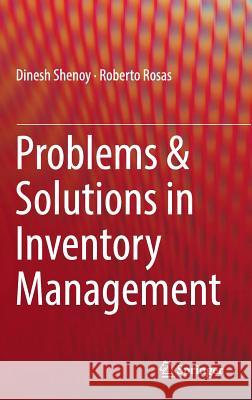Problems & Solutions in Inventory Management » książka



Problems & Solutions in Inventory Management
ISBN-13: 9783319656953 / Angielski / Twarda / 2017 / 283 str.
Problems & Solutions in Inventory Management
ISBN-13: 9783319656953 / Angielski / Twarda / 2017 / 283 str.
(netto: 287,51 VAT: 5%)
Najniższa cena z 30 dni: 289,13
ok. 22 dni roboczych
Bez gwarancji dostawy przed świętami
Darmowa dostawa!
Wydanie ilustrowane
"This book is one of the most comprehensive books in inventory management. The authors provide some case studies, problems and solutions in each chapter. ... This book is a must-read for people who want to learn about and master inventory management and its models, techniques and applications in real life." (Dharma Lesmono, Mathematical Reviews, April, 2018)
1. Inventory Management – an Overview
1.1. History of Inventory Management
1.2. Structure of the book
2. Basics of Inventory Management
2.1. Introduction to the Tortilla Case Study2.2. What is Inventory
2.3. Types of Inventory
2.4. Need for Inventory
2.5. The Inventory Management Problem
2.6. Cost parameters and computation2.7. Inventory Model and Policies
2.8. Case Study & numerical problems with answers
3. Deterministic Inventory Model
3.1. Introduction (with reference to case study)3.2. The General EOQ Model
3.3. Inventory Model with Planned Shortages / backordering
3.4. Inventory Model with finite replenishment rate
3.5. Inventory Model with shortages (lost business)3.6. Case Study & numerical problems with answers
4. Dynamic Inventory Model (Quantity Discount)
4.1. Introduction (with reference to case study)
4.2. Complete Order / All Units discount4.3. Incremental discount
4.4. Special Order Quantity/One-off Discount
4.5. Case Study & numerical problems with answers
5. Lot Sizing Heuristics
5.1. Introduction (with reference to case study)
5.2. Lot for Lot
5.3. Part Period Balancing
5.4. Silver Meal
5.5. Least Unit Cost
5.6. Wagner-Whitin
5.7. Case Study & numerical problems with answers
6. Multi-Item Inventory Models
6.1. Introduction (with reference to case study)6.2. Inventory Model with Budget Constraint
6.3. Inventory Model with Space Constraint
6.4. Inventory Model with Number of Orders Constraint
6.5. Inventory Model with Coordinated Supply6.6. Case Study & numerical problems with answers
7. Stochastic Inventory Models
7.1. Introduction (with reference to case study)
7.2. Modelling variable Demand7.3. Computing Lot-size & Reorder Point (Q,R)
7.4. Modelling variable Lead Time
7.5. Applying Service Levels, computing safety stock
7.6. Single Period (News Vendor) Inventory Problem7.7. Case Study & numerical problems with answers
8. Selective Inventory Management
8.1. Introduction
8.2. Need for Selective Inventory Management
8.3. ABC, VED & FSN Analysis8.4. Case Study & numerical problems with answers
9. Multi-Echelon Inventory Models
9.1. Introduction
9.2. Simple Warehouse-Retailer Model under certainty – Constant Demand9.3. Simple Warehouse-Retailer Model under certainty – Time Varying Demand
9.4. Simple Warehouse-Retailer Model under uncertainties
9.5. Case Study & numerical problems with answers
10. Inventory Models for Perishable Items
10.1. Introduction
10.2. Revisiting the Single Period (News Vendor) Problem – Life of item is known
10.3. Extension to multiple periods
10.4. Case Study & numerical problems with answers
11. Maintenance Repair Operations (MRO) Inventories
11.1. Introduction
11.2. Ordering policies for slow moving spare parts
11.3. Application of (S-1,S) model for slow moving spares11.4. Optimizing number of repairable/rotable spares
11.5. Utilizing multi-echelon inventory systems for managing spares (Risk pooling)
11.6. Case Study & numerical problems with answers
Appendices
1. MS Excel functions for probability distributions with examples
2. References / Bibliography / Additional Reading
Prof. Dr. Dinesh Shenoy is a Professor of Industrial Engineering at Tecnológico de Monterrey (ITESM), Mexico. He teaches Inventory Management and allied courses in Operations Management to senior undergraduate students. He is best known for his contributions to the field of Spare Parts Management and is the author of Maintenance Resources Management: Adapting MRP (Taylor & Francis, 1998). Dinesh received his doctoral degree from Indian Institute of Technology, Kharagpur, India, in 1995. Between 1995 and 2009, Dinesh worked with large multinational organizations such as ANZ Bank (Melbourne), Thomson Financial in Bangalore and Barclays Capital (Singapore) and relieved in leadership roles in Operations and Technology. He was also a visiting faculty member at Narsee Monjee University between 2010 and 2016.
Prof. Dr. Roberto Rosas is the Head of Engineering and Sciences Department at Tecnológico de Monterrey (ITESM), León, Mexico. He teaches Production Management and allied courses in Operations Management and Manufacturing to undergraduate students. His relevant experience is in the field of Design of Manufacturing Systems, Simulation of Manufacturing Systems, Theory of Constraints, Enterprise Resource Planning, Lean Manufacturing, Six Sigma and Operations Management. Prof. Rosas received his master’s degree from Tecnológico de Monterrey, Monterrey, Mexico, in 2003. Between 2001 and 2007, Rosas worked in industries such as Leather and Footwear, Engineering Services. During the last seven years, he has worked in education and has developed several projects as Consultant in industry related to his expertise.
This book presents a compilation of over 200 numerical problems and solutions that students can use to learn, practice and master the Inventory Control and Management concepts.
Intended as a companion to any of the standard textbooks in Inventory Control and Management and written in simple language, it illustrates very clearly the steps students need to follow in order to solve a given problem. It also explains which solution methodologies can be used under which circumstances.
Offering an ideal one-stop resource for mid-level engineering and business students who have taken Inventory Management or a related subject as an elective, this book is the only one students will ever need to prepare and gain confidence for their examinations in this subject.1997-2025 DolnySlask.com Agencja Internetowa
KrainaKsiazek.PL - Księgarnia Internetowa









